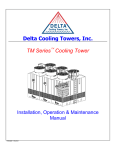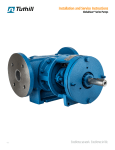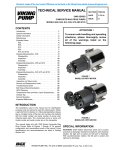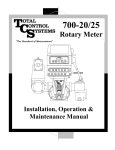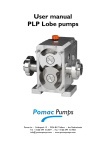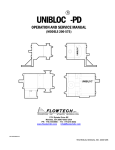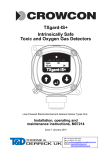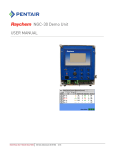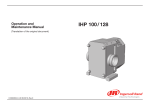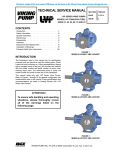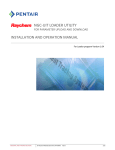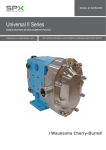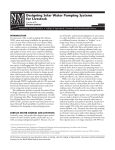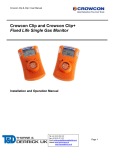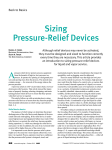Download instruction and maintenance manual
Transcript
SAFETY INFORMATION INCORRECT INSTALLATION, OPERATION OR MAINTENANCE OF EQUIPMENT MAY CAUSE SEVERE PERSONAL INJURY OR DEATH AND/OR EQUIPMENT DAMAGE AND MAY INVALIDATE THE WARRANTY. This information must be read fully before beginning installation, operation or maintenance and must be kept with the pump. All installation and maintenance must be undertaken by suitably trained or qualified persons only. Symbol Legend : ! ! Danger - Failure to follow the listed precautionary measures identified by this symbol may result in serious injury or death. DO NOT OPERATE PUMP IF: – The front cover is not installed correctly. ! DO NOT place fingers, etc. into the pumping chamber or its connection ports or into any part of the drive train if there is ANY possibility of the pump shafts being rotated. Severe injury will occur. ! DO NOT exceed the pumps rated pressure, speed, and temperature, or change the system/duty parameters from those for which the pump was originally supplied, without confirming its suitability for the new duty. WARNING ! ! WARNING INSTALLATION AND OPERATION OF THE PUMP MUST ALWAYS COMPLY WITH HEALTH AND SAFETY REGULATIONS. A device must be incorporated into the pump, system, or drive to prevent the pump exceeding its stated duty pressure. It must be suitable for both directions of pump rotation where applicable. Do not allow pump to operate with a closed/blocked discharge unless a pressure relief device is incorporated. If an integral relief valve is incorporated into the pump, do not allow re-circulation through the relief valve for extended periods. The mounting of the pump or pump unit should be solid and stable. Pump orientation must be considered in relation to drainage requirements. Once mounted, shaft drive elements must be checked for correct alignment. Rotate pump shaft by at least one full revolution to ensure smoothness of operation. Incorrect alignment will produce excessive loadings and will create high temperatures and increased noise emissions. The installation must allow safe routine maintenance and inspection (to check for leakage, monitor pressures, etc) and provide adequate ventilation necessary to prevent overheating. Before operating the pump, be sure that it and all parts of the system to which it is connected are clean and free from debris and that all valves in the suction and discharge pipelines are fully opened. Ensure that all piping connecting to the pump is fully supported and correctly aligned with its relevant connections. Misalignment and/or excess loads will cause severe pump damage. Be sure that pump rotation is correct for the desired direction of flow. WARNING WARNING – Any guards are missing or incorrectly installed. – The suction or discharge piping is not connected. ! WARNING DO NOT INSTALL THE PUMP INTO A SYSTEM WHERE IT WILL RUN DRY (I.E. WITHOUT A SUPPLY OF PUMPED MEDIA). SECTION IOM TRA®10 ISSUE B PAGE 2 OF 20 ! ! Warning - Safety instructions which shall be considered for reasons of safe operation of the pump or pump unit and/ or protection of the pump or pump unit itself are marked by this symbol. Pressure gauges/sensors are recommended, next to the pump suction and discharge connections to monitor pressures. Caution must be taken when lifting the pump. Suitable lifting devices should be used as appropriate. Lifting eyes installed on the pump must only be used to lift the pump, not pump with drive and/or baseplate. If pump is baseplate mounted, the base plate must be used for all lifting purposes. If slings are used for lifting, they must be safely and securely attached. For weights of bare shaft pumps refer to catalog. DO NOT attempt any maintenance or disassembly of the pump or pump unit without first ensuring that : – The pump is fully isolated from the power source (electric, hydraulic, pneumatic). – The pumping chamber, relief valve and any shaft seal support system are depressurized and purged. – Any temperature control devices (jackets, heattracing, etc) are fully isolated, that they are depressurized and purged, and components are allowed to reach a safe handling temperature. ! ! ! ! WARNING DO NOT attempt to dismantle a pressure relief valve which has not had the spring pressure relieved or is mounted on a pump that is operating. Serious personal injury or death and/or pump damage may occur. DO NOT loosen or undo the front cover, any connections to the pump, shaft seal housings, temperature control devices, or other components, until sure that such action will not allow the unsafe escape of any pressurized media. Pumps and/or drives can produce sound power levels exceeding 85 dB(A) under certain operating conditions. When necessary, personal protection against noise must be taken. Avoid any contact with hot parts of pumps and/or drives which may cause injury. Certain operating conditions, temperature control devices (jackets, heattracing, etc.), bad installation, or poor maintenance can all promote high temperatures on pumps and/or drives. When cleaning, either manually or by CIP method, the operator must ensure that a suitable procedure is used in accordance with the system requirements. During a CIP cleaning cycle, a pump differential pressure of between 30 and 45 psi is recommended to ensure suitable velocities are reached within the pump head. The exterior of the pump should be cleaned periodically. tools required for disassembly / assembly 1. “O” ring removal tool—supplied with pump 2. Rotor nut wrench—supplied with pump 3. Soft-faced hammer figure 2 4. Suitable gear puller 5. Allen wrenches 6. Hydraulic press 7. Suitable V blocks 8. Measuring tools 9. Spanner wrenches for gear end lock nuts—available from Wright Flow Technologies •WT0150SPWRENCH •WT0300SPWRENCH •WT0600SPWRENCH •WT2200SPWRENCH The pumped medium is carried around the rotorcase by the rotors to the discharge side of the pump, here the cavity decreases and the pumped medium is discharged from the rotorcase. TRA10 Range Operating Parameters: The maximum pressure and speed operating parameters are given in Pump Performance Tables 2 & 2A. In practice these may be limited due to the nature of the product to be pumped and/or design of the system in which the pump is to be installed. Consult Wright Flow Technologies or your Wright Flow Technologies distributor for assistance. normal operation The operating temperature limit of the pump is determined by the rotor clearance. Normal operation of most Wright Flow TRA® 10 Series pumps is within a range of 0 to 600 rpm, with a pressure range of 0 to 200 psi. Standard rotors operate within a temperature range of –40°F to 200°F. Hot clearance rotors operate at 200°F to 300°F. Consult factory for operation at other values. Refer to Table 1. For the circumferential piston pumps (CPP): ● TRA10 Series - four rotor clearance bands: a) Standard b) FF (Front Face) c) Hot d) Extra Pump Characteristics: The pump should not be subjected to sudden temperature changes to avoid the risk of damage from sudden expansion/ contraction of components. Care should be taken when selecting pumps for handling liquids containing abrasive particles as these may cause wear of pump head components. Wright Flow Technologies TRA10 pumps are positivedisplacement, low-slip, stainless steel pumps designed with larger diameter shafts for greater strength and stiffness, mounted on a heavy-duty cast iron bearing frame (stainless steel option available) with double tapered roller bearings. ● Up to 200 psi (13.8 bar) pressure capability. ● No bearings in the product zone. ● Heavy-duty bearing frame with large diameter shafts. ●Greased lubed bearings for positive lubrication to all bearings over entire speed, temperature and pressure range. ●Non-galling ASTM A-494 rotors are standard; permits running at tighter clearances and pumping a wide range of viscosities. General TRA10 Pumping Principal: The pumping action is generated by the counter-clockwise rotation of two pumping elements (rotors) within a chamber (rotorcase) - see Figure 2. The rotors are located on shafts, which in turn are mounted within an external gearbox and supported by the bearings; the timing gears are also located on the shafts. The timing gears transfer the energy from the drive shaft to the driven shaft, synchronising the rotors such that they rotate without contact with each other. As the rotors pass the inlet port, see Figure 2, the cavity generated increases creating a pressure decrease, which induces the pumped medium to flow into the rotorcase. Operating Temperature Limit °C (°F) TRA10 Series Circumferential Piston Standard FF Hot Extra 93°C (200°F) 105°C (221°F) 150°C (302°F) Refer to WFT TABLE 1 ! WARNING ! The Net Positive Suction Head available (NPSHa) from the system must always exceed the Net Positive Suction Head required (NPSHr) by the pump. Observing the following general guidelines should ensure the best possible suction condition is created. ●Suction piping is at least the same diameter as the pump connections. ● The length of suction piping is kept to the absolute minimum. ●The minimum number of bends, tees and pipework restrictions are used. ● Calculations to determine system NPSHa are carried out for the worst condition, see below. Should advice on pump or system NPSH characteristics be required contact the factory or their authorised distributor. SECTION IOM TRA®10 ISSUE B PAGE 3 OF 20 For Suction Lift Or Vacuum Conditions. INSTALLATION POSITIONS For Conditions With Positive Suction Head. 4-Way Mounting Suction Head Atmospheric Pressure NPSH Available Horizontal ports, bottom shaft position 10.0 Meters (32.8 F eet) Water C olumn NPSH Available Suction Lift Or Vacuum Suction Line Friction Loss Suction Line Friction Loss Horizontal ports, top shaft position Vertical ports, left-hand or right-hand shaft position Vapour Pressure Vapour Pressure Atmospheric Vacuum tra®10 pump performance TRA®10 Model Displacement Maximum per Pressure Revolution Nominal Capacity GPM M3/hr Gal. Liter Deg. C Optional Ports in. mm Maximum Speed (RPM) in. mm 6.0 1.3 0.008 0.030 200 14 -40° to 300° -40° to 150° 1.5 38 1.0 25.4 800 0150 9.0 2.0 0.014 0.052 200 14 -40° to 300° -40° to 150° 1.5 38 — 700 0180 17.0 3.8 0.03 14 -40° to 300° -40° to 150° 1.5 38 2.0 51.0 600 0300 36.0 8.2 0.06 0.23 200 14 -40° to 300° -40° to 150° 1.5 38 2.0 51.0 600 0450* 59.0 13.3 0.10 0.38 400 27 -40° to 300° -40° to 150° 2.0 51 — 600 200 Deg. F Standard Ports 0060 0.11 PSI Bar Temperature Range — — 0600 90.0 20.4 0.15 0.58 200 14 -40° to 300° -40° to 150° 2.5 64 3.0 76.0 600 1300 150.0 34.1 0.25 0.96 200 14 -40° to 300° -40° to 150° 3.0 76 4.0 102.0 600 2200 310.0 70.4 0.52 1.98 200 14 -40° to 300° -40° to 150° 4.0 102 — — 600 3200 450.0 102.0 0.75 2.85 200 14 -40° to 300° -40° to 150° 6.0 152 — — 600 (Example of Rectangular Flange model) table 2 - Pump performance parameters TRA®10 Rectangular Flange Model 0240 Nominal Capacity Displacement Maximum per Pressure Revolution GPM M3/hr Gal. Liter PSI Bar 0.03 0.11 200 14 Temperature Range Deg. F Deg. C Inlet (W x L) in. -40° to 300° -40° to 150° 1.31 x 4.93 Outlet mm in. mm 33.27 x 125.22 1.5 38.1 Maximum Speed (RPM) 11.6 2.5 0340 24.0 5.4 0.06 0.22 200 14 -40° to 300° -40° to 150° 1.75 x 6.75 44.50 x 171.45 2.0 50.8 400 0640 60.0 13.6 0.15 0.57 200 14 -40° to 300° -40° to 150° 2.24 x 8.82 56.90 x 224.03 2.5 57.2 400 75.44 x 234.95 3.0 76.2 400 4.0 101.6 400 1340 100.0 22.7 0.25 0.96 200 14 -40° to 300° -40° to 150° 2.97 x 9.25 2240 200.0 45.4 0.52 1.97 200 14 -40° to 300° -40° to 150° 3.87 x 11.00 98.30 x 279.40 table 2a - Pump performance parameters - rectangular flange models SECTION IOM TRA®10 ISSUE B PAGE 4 OF 20 400 PORT CONFIGURATIONS PERFORMANCE RANGE ● Capacity Range: 0.1 to 450 gpm (0.02 to 102 m3/hr) ● Pressure Range: to 200 PSI/14 Bar * Model 0450 to 400 PSI/27 Bar ● Temperature Range: -40°F to +300°F (-40°C to +150°C) Note: Hot clearances required for high temp operation Sanitary Clamp ● Viscosity Range: 28 to 910,000 SSU (1 to 200,000 cPs) Note: Consult factory for applications greater than 910,000 SSU/200,000 cSt. Chocolate clearances available. Bevel Seat (ACME) Other port configuration options include: ● DIN 11851 ●SMS ●RJT ● 150# or 300# flange ●NPT ● Rectangular inlet flange tra®10 dimensions OPTIONAL FOOT LOCATION Model 0060 0150 0180 0300 0450 0600 1300 2200 3200 in. A B C D E F G H I J K L M N O P QØ R S Weight 4.75 2.34 3.20 12.04 5.50 1.94 2.31 0.375 x 0.31 (slot) 6.82 2.93 9.61 1.81 2.00 4.21 1.50 2.79 0.875 3.49 6.97 53 lb. mm 121 in. 4.75 2.34 3.20 12.04 5.50 1.94 2.31 0.375 x 0.31 (slot) 6.82 2.93 9.61 1.81 2.00 4.21 1.50 2.79 0.875 3.49 6.97 59 53 lb. mm 121 24 kg 59 81 81 303 303 140 140 49 49 59 59 9.5 x 8 (slot) 9.5 x 8 (slot) 173 173 74 74 244 244 46 46 51 51 107 107 38 38 71 22.23 89 71 22.23 89 177 177 24 kg in. 4.75 2.34 3.20 12.46 5.50 1.94 2.31 0.375 x 0.31 (slot) 6.82 2.93 9.84 1.81 2.00 4.21 1.50 3.02 0.875 3.55 7.09 53 lb. mm 121 180 24 kg 59 81 316 140 49 59 9.5 x 8 (slot) 173 74 250 46 51 107 38 77 22.23 90 in. 6.25 2.78 4.25 14.52 6.86 2.42 2.56 0.438 x 0.44 (slot) 7.77 3.56 11.61 2.62 2.32 5.21 1.50 3.84 1.250 4.25 8.50 99 lb. mm 159 45 kg in. 8.25 4.14 5.87 18.91 9.56 3.50 4.12 0.56 x 0.50 (slot) 10.14 5.06 15.42 3.50 2.15 7.31 2.00 5.28 1.625 5.38 10.75 290 lb. 71 105 108 122 149 9.0 216 229 mm in. mm 129 499 243 89 105 105 295 257 129 385 89 59 401 89 55 132 89 55 186 38 55 186 51 98 31.75 108 186 63 134 41.28 136 216 76 127 41.28 136 273 144 41.28 136 273 132 kg 273 132 kg 142 kg 23.29 12.38 3.75 7.25 0.56 x 0.19 (slot) 12.74 6.38 18.49 4.50 2.63 9.38 4.00 5.75 2.000 6.63 13.25 555 lb. 592 314 95 184 12.00 4.12 11.63 30.17 13.88 5.25 8.00 305 14 x 13 (slot) 129 392 67 210 210 258 129 295 8.25 4.79 5.87 19.66 9.56 3.50 4.12 0.56 x 0.50 (slot) 10.12 5.06 15.77 3.50 2.15 7.31 3.00 5.65 1.625 5.37 10.75 312 lb. 8.50 5.07 14 x 13 (slot) 258 90 in. in. 105 14 x 13 (slot) 197 mm mm 89 105 11 x 11 (slot) 210 243 89 65 8.25 4.14 5.87 18.73 9.56 3.50 4.12 0.56 x 0.50 (slot) 10.14 5.06 15.14 3.50 2.15 7.31 2.50 5.00 1.625 5.37 10.75 290 lb. 480 243 61 in. 149 480 174 mm 105 149 369 766 353 133 203 14 x 5 (slot) 0.66 Ø 16 Ø 324 162 470 114 67 238 102 146 50.80 168 337 252 kg 16.55 6.88 21.92 5.06 4.06 10.38 6.00 5.37 2.375 8.00 16.00 1050 lb. 420 175 557 129 103 264 152 136 60.45 203 SECTION IOM TRA®10 ISSUE B 406 477 kg PAGE 5 OF 20 equipment serial number All Wright Flow Technologies pumps are identified by a serial number on the gear case nameplate, which is stamped on the pump body and cover. ! CAUTION ! The gear case, body, and cover must be kept together as a unit due to backface, rotor, and cover clearances. Failure to do so will damage the pump. INSTALLATION Installation should follow good practice to provide the best performance and must meet local code requirements. All system components must be correctly sized to provide satisfactory operation of your Wright Flow Technologies product. Consideration must be given to the following in order to achieve proper installation: 1. Pumps of this type are usually mounted on a base plate common with the drive unit. Bases may be permanently mounted, be self-leveling with vibration isolation pads, have adjustable legs or be portable. Bases should be level during pump operation. 2. Provide power as required by the motor and controls as needed for system operation. ↯ WARNING ! Electrical connections must be made by a registered electrician in accordance with local codes and standards. ↯ WARNING ! To avoid serious injury or death, do not install or service pump unless power is off and locked out. 3. Piping should be supported independently of the pump to prevent mis-alignment of pump parts that will cause excessive wear to rotors, bearings and shafts. Use of thermal expansion (flexible) joints will also minimize forces exerted on the pump. Inlet and outlet valves permit servicing of the pump without emptying the entire system. Inlet piping must not slope toward the pump in such a way as to cause formation of an air pocket ahead of the pump. An inlet valve will serve to keep the inlet line full. This is particularly important with low viscosity fluids and with frequent starts and stops. With low absolute inlet pressure, a check on the outlet side of the pump prevents backflow and minimizes start-up differential pressure. SECTION IOM TRA®10 ISSUE B PAGE 6 OF 20 ATTENTION CAUTION ! Operation of the pump with inlet and/or outlet valves in the closed position can cause damage to the pump. 4. Welding of fittings is not recommended since warpage can occur which may effect pump operation and performance. 5. Overpressure protection must be provided for this pump. A pump mounted pressure relief valve, a torque limiting device on the drive or a rupture disc in the discharge piping are examples. If pump rotation is to be reversed, pressure protection must be provided on both sides of the pump. ! WARNING ! Do not operate pump unless overpressure protection is installed in discharge piping. 6. Inlet side strainers or traps can be used to prevent foreign objects from entering and damaging the pump. Selection should be made based on viscosity to prevent clogging and restricting the inlet thus causing cavitation and reduction of flow from the pump. 7. Installation of pressure and/or vacuum gauges at inlet and/or outlet provide a convenient way to assess pump operation. Such gauges can indicate if pressure is normal or not, show changes in pump or system conditions, and provide indications of flow and changes in viscosity. 8. Pumps and drives ordered from the factory on a common base plate have been supplied with a flexible coupling and aligned before shipping. This alignment should be rechecked after the pump is installed and piping is complete. To check units coupling alignment begin with checking the angular alignment by measuring the gap between the couplings at four points. Shim the drive assembly accordingly so the gaps are an equal distance at all points (Figure 3). Next check the horizontal and vertical alignment of the couplings using a straight edge. Place the straight edge along the coupling to ensure that both sides are concentric with each other (Figure 4). figure 3 13. Make sure inlet and outlet connections are tightened. If pump has double seals connect seal flushing piping. WARNING ! ! Do not operate pump without guards in place. figure 4 9. Turn pump shaft manually to make sure that the pump turns freely. ! WARNING ! Do not put fingers in ports or near rotating members. 10. Jog motor and observe motor coupling to make sure pump will turn in the right direction. See Figure 5. WARNING ! ! Do not put fingers in ports or near rotating members. These connections are normally 1/8” female pipe threads. Liquid used for flushing can be connected of the seals and discharged to drain on the opposite side. Flow should be about 1/4 GPM, but may be increased for high temperature applications, but should be kept as near to 1/4 GPM as possible to avoid seal damage. 14. Lubrication (Refer to Tables 3 and 4) Gears are lubricated with oil conforming to ISO 460, SAE 140, AGMA grade 7 or FDA 21 CFR 178.3570 for top or bottom shaft mounting position and oil is added at the factory. Oil Amount (gears) Top Shaft Drive Bottom Shaft Drive figure 5 ! WARNING ! Stay clear of motor shaft and coupling when jogging motor. 11. Lock out power to pump. 12. Connect coupling halves and install coupling guard. ! WARNING ! To avoid serious injury or death, do not install or service pump unless power is off and locked out. Grease Amount (per fitting) Model Top/Bottom Mount Side Mount Front Rear 0060, 0150, 0180 1.3 oz (40 mL) 3.3 oz (100 mL) 0.37 oz (11 cc) 0.13 oz (4 cc) 0300 2.0 oz (60 mL) 4.0 oz (120 mL) 0.60 oz (18 cc) 0.21 oz (6 cc) 0450, 0600, 1300 6.0 oz (170 mL) 9.5 oz (280 mL) 0.84 oz (25 cc) 0.76 oz (22 cc) 2200 11.0 oz (320 mL) 20.0 oz (600 mL) 1.33 oz (39 cc) 1.03 oz (30 cc) 3200 17.0 oz (500 mL) 44.0 oz (1300 mL) 1.96 oz (58 cc) 1.16 oz (34 cc) table 3 - Lubricating oil and grease amount Governing Standard Suggested Brand Names Lubricating Oil Grease Conforming to ISO 460 or SAE 140 or AGMA grade 7, and FDA 21 CFR 178.3570. Conforming to ISO 220 or NLGI grade 2, and NSF USDA-H1 Chevron Lubricating Oil FM ISO 460 Chevron FM Grease CSC 2 EP or equivalent to Governing Standard or equivalent to Governing Standard table 4 - suggested Lubricating oil and grease brand Bearings are greased with grease conforming to ISO 220, NLGI grade 2 or NSF USDA-H1. Grease bearings after every 250 hours of operation; change oil every 500 hours. Where moisture and/or condensation are heavy change oil and grease more frequently. If temperature is 5°F or below, bearings should be greased with silicon grease. SECTION IOM TRA®10 ISSUE B PAGE 7 OF 20 STARTUP CHECKLIST Has protection from high pressure been considered? See Installation, step 5. Are pump and all piping clean and free of foreign material, gaskets, weld slag, bolts etc.? DO NOT USE PUMP TO CLEAN SYSTEM. Are connections tightened and leak free? Is gear drive properly lubricated? See Installation, step 14. Are all guards in place and secure? Have seals requiring flushing been supplied with an adequate supply of clean flushing fluid? Are all valves open on the discharge side of the pump? Are all valves open on the inlet side of the pump, and is the material to be pumped reaching the pump? Is direction of rotation correct? See Installation, step 10. Jog or start pump at low speed when possible. Check to see that pump is performing properly within several minutes. If problems are detected, see Troubleshooting Guide. CLEANING AND MAINTENANCE Wright Flow Technologies products are designed for easy removal of the cover, rotors and seals for cleaning when necessary. See instructions under Pump Head and Seal Disassembly/Assembly. Cleaning in place is not recommended. ! WARNING ! To avoid serious injury or death, do not install or service pump unless power is off and locked out. ! WARNING ! Relieve system pressure before removing cover or port connections. ATTENTION CAUTION ! Handle all parts with care to avoid nicks and scratches which may affect pump operation. 1. Remove rotor case cover 2. Remove rotor retainers and ensure components are dry before servicing. 3. With a penlight, inspect shaft threads for contamination. If soiled, refer to cleaning procedure below 4. Install rotor retainer and use a torque wrench to tighten torque setting specified in this manual. 5. Install the rotor case cover and use a torque wrench to tighten cover nuts to torque setting specified in this manual. Cleaning Procedure for Circumferential Rotor and Rotary Lobe Shaft Threads: 1. Remove rotor retainer devices from the shaft. 2. Submerge and soak retainer part/s for 5 minutes in clean out of place (COP) tank with 2% caustic solution. 3.While wearing the appropriate personal protective equipment (PPE) scrub the part/s vigorously with a sanitary bristle brush for two minutes while submerged. 4. Procure a clean sanitary brush of a size that engages the shaft threads with enough interference to remove contaminants. While wearing the appropriate PPE. Scrub the shaft threads vigorously with the sanitary brush while consistently flushing with a 2% caustic solution using a spray bottle. 5. Soak all above parts in acid sanitizer for 5 minutes, and then scrub again. 6. Flush shaft threads with acid sanitizer for 5 minutes using spray bottle, and then scrub the hole again with the pipe brush for two minutes. 7. Rinse well with clean water and blow-dry blind tapped hole with clean air. 8. Swab test to determine cleanliness. 9. Should the swab test fail, repeat steps 2 thru 8 above until swab test is passed. PREVENTIVE MAINTENANCE Simple inspection during cleaning will often detect signs of a problem before it becomes serious so that it can be corrected at minimal cost and down-time. Remove rotors as described in Step 1 of Pump Head and Seal Disassembly/Assembly. Visually inspect rotor wing tips for signs of metal-to-metal contact. If present the pump should be repaired or replaced. Possible causes: Cleaning Worn shaft spline — replace shaft. Clean per established procedures. Be aware of the cleaning solution used (see MSDS), and of cleaning solution temperature. Make sure no residual cleaning solution stays in the pump. Note that acidic cleaners have a high metal corrosion rate, so pump parts should be exposed to these cleaners no longer than necessary and be completely rinsed. SECTION IOM TRA®10 Seal Replacement Procedure: ISSUE B PAGE 8 OF 20 Worn rotor spline — replace rotor (usually both parts wear, often due to running a loose rotor). Loose or worn gears, key, keyway shaft — inspect and replace as needed. Visually inspect the rotor hub where it contacts the shoulder on the shaft for wear. Possible cause: Running loose rotor — replace rotor and correctly tighten or re-shim shaft to maintain backface clearance. Inspect shoulder on shaft for wear. Possible cause: Running loose rotor — replace or re-shim shaft. Check gear backlash. Replace nuts and turn shaft with wrench. There should be no free movement of either shaft. Possible causes: Worn gear teeth — replace gear Gear loose on shaft — remove gear, inspect key, keyways and shaft. Replace worn parts and retighten. Check condition of bearings. Hand load (about 30 lbs.) each shaft. There should be no detectable movement. figure 7 2. Drain oil, remove gear box cover and inspect gears for wear, backlash, and looseness. Retighten as needed. 3. Carefully inspect rotors visually for worn splines, bearing shoulder wear, and for stress cracks. Replace worn or cracked rotors. See Figure 8. Cause of movement: Bearings worn due to lack of lubrication or overload — replace bearings and ensure adequate lubrication, reduce hydraulic load. If gear box disassembly is required, refer to Gear Box Disassembly and Assembly. When pump is assembled there must be equal clearance where shown. See Figure 6. Follow lubrication intervals as shown in Tables 3 and 4. figure 8 4. See Table 6 under Standard Clearances and check radial and back face clearance to determine wear. See Pump Head and Seal Disassembly/Assembly for disassembly and assembly. When replacing bearings or shafts in the field care must be taken to properly shim the shaft to provide the correct clearances between the rotors, body and cover. figure 6 annual MAINTENANCE Conduct the same checks as above, and in addition do the following: 1. Check bearings for radial play using a dial indicator as shown. If indicator reading is equal to or greater than the rotor to body clearance in Table 6 under Standard Clearances, replace bearings. See Figure 7. Operating speed adjustment can compensate for wear in some applications. When performance is no longer acceptable, you may take advantage of the Wright Flow Technologies remanufacturing plan, as follows: REMANUFACTURING PROGRAM: Wright Flow TRA10 Pumps may be remanufactured up to four times depending on use and wear. Remanufactured pumps are backed with the same warranty as a new pump. Factory remanufacturing involves body and cover remachining, new rotors, and replacement of all worn parts such as shafts, bearings, gears etc. To facilitate the remanufacturing process contact the factory to discuss the particular pump(s) to be remanufactured and obtain return goods authorization. It may be possible to supply a reconditioned pump in advance of returning a pump to the factory although not all sizes may be available at any one time. Be sure to clean and flush pump before returning it to the factory. SECTION IOM TRA®10 ISSUE B PAGE 9 OF 20 pump head and seal assembly and disassembly Before disassembly, lock out power and release pressure from pump. ! WARNING ! To avoid serious injury or death, do not install or service pump unless power is off and locked out. ! WARNING ! Relieve system pressure before removing cover or port connections. ATTENTION CAUTION ! Handle all parts with care to avoid nicks and scratches which may affect pump operation. 1. PUMP HEAD DISASSEMBLY Remove wing nuts using a soft hammer. Remove cover. If necessary, tap cover with soft hammer to loosen. Remove and discard cover “O” ring. Use wrench supplied to remove rotor nuts. Nuts remove in a counter clock-wise direction. Hit wrench sharply with soft hammer to loosen nuts. Double “O” Ring (See Figure 11) Remove “O” ring carriers; remove and discard rings from both carriers and body. Use “O” ring removal tool furnished. Single Mechanical Seal (See Figure 12) Inner Seal: Remove seal from body. If chipped, scratched or evidence of cracks, discard seal. Make sure shoulder is clean; remove burrs if present; remove and discard “O” rings. Seal Seat: Remove seal seat from shaft. If chipped, scratched or evidence of cracks, discard seal. Make sure shoulder is clean; remove burrs if present; remove and discard “O” rings. Double Mechanical Seal (See Figure 13) Inner Seal: Remove seal from body. If chipped, scratched or evidence of cracks, discard seal. Make sure shoulder is clean; remove burrs if present; remove and discard “O” rings. Outer Seal: Remove seal from body. If chipped, scratched or evidence of cracks, discard seal. Remove and discard “O” rings. Seal Seat: Remove seal seat from shaft. If chipped, scratched or evidence of cracks, discard seal. Make sure shoulder is clean; remove burrs if present; remove and discard “O” rings. Orient rotors perpendicular to each other, then remove rotor with both wings exposed first. If necessary use gear puller or hardwood lever to remove rotor from spline. See Figure 9. figure 10 SINGLE “O” RING SEAL figure 11 DOUBLE “O” RING SEAL figure 12 SINGLE MECH. SEAL figure 13 DOUBLE MECH. SEAL figure 9 If fitted with Allen head hold down bolts in the body remove them, then remove pump body by pulling it straight off studs. Note that the pump body must be assembled to the same bearing housing from which it was removed. 2. SEAL DISASSEMBLY (For 3200 model pump, consult factory) Single “O” Ring (See Figure 10) Remove and discard body and shaft “O” rings. Use “O” ring removal tool furnished with pump. SECTION IOM TRA®10 ISSUE B PAGE 10 OF 20 3. SEAL ASSEMBLY (For 3200 model pump, consult factory) Prior to reassembling the pump head inspect all parts to make sure they are free from damage. Nicks, scratches and cracks in mechanical seal components may cause seal leakage, and nicks, scratches and burrs on any pump part may cause leakage or performance problems. Refer to sketches with disassembly instructions. Single “O” ring (See Figure 10) Apply a suitable “O” ring lubricant to new “O” rings and insert them into the body and shaft grooves. “O” rings on shafts should be installed in the groove closest to the spline. Assemble shaft sleeves against shaft shoulder. If sleeve is slotted, assemble with slot over drive pin in shaft. If sleeve has prongs assemble with prongs on either side of drive pin. Do not re-use sleeves that are grooved or scratched. Double “O” ring (See Figure 11) Apply a suitable “O” ring lubricant to new “O” rings and insert them into the body, carrier and shaft grooves. “O” rings on shafts should be installed in the groove closest to the spline when using “O” ring seats. Assemble carriers into body so carrier notch engages pin in body. Assemble shaft sleeves against shaft shoulder. If sleeve is slotted, assemble with slot over drive pin in shaft. If sleeve has prongs assemble with prongs on either side of drive pin. Do not re-use sleeves that are grooved or scratched. Single Mechanical Seal (See Figure 12) Seal Seat: Apply a suitable “O” ring lubricant to new “O” rings and insert them into shaft grooves furthest from spline. Install seal seats lining up groove on rear face with shaft drive pin. Inner Seal: Apply a suitable “O” ring lubricant to new “O” rings and insert them into body grooves. Assemble wave spring on seal and install into body with notch engaging pin in body. Lubricate seal faces. Double Mechanical Seal (See Figure 13) Seal Seat: Apply a suitable “O” ring lubricant to new “O” ring and insert into shaft groove furthest from spline. Install seal seat lining up groove on rear face with shaft drive pin. Inner Seal: Apply a suitable “O” ring lubricant to new “O” ring and insert into body groove. Assemble wave spring on seal and install into body with notch engaging pin in body. Insert seal assembly into body engaging notch with pin and pushing from opposite side, over and in, to seat “O” ring. Apply lubricant to seal faces. 4. PUMP HEAD ASSEMBLY Slide body over shafts and studs taking care not to damage seal parts. Press body firmly against gear case engaging dowels. Install Allen Head body hold down bolts, where furnished. Assemble rotor to its shaft engaging the large spline tooth with large groove in rotor. Rotate shaft until rotor wings are on a vertical centerline, then install second rotor. Secure with rotor retaining nuts: tighten first nut on shaft by striking nut wrench with soft faced hammer, then tighten second nut against first in the same way to jam nuts together. Place cover “O” ring in groove, push cover over studs making sure “O” ring remains in groove. Insert a plastic or other soft dowel to clock rotor against pump body, then tighten each nut by striking with a soft hammer. Sterilize pump in accordance with accepted sterilization procedures. Make sure no residual solution remains in the pump. gear box disassembly and assembly ! WARNING ! To avoid serious injury or death, do not install or service pump unless power is off and locked out. ! WARNING ! Relieve system pressure before removing cover or port connections. GEAR BOX DISASSEMBLY 1. Remove pump head as described in step 1 of Pump Head and Seal Disassembly/Assembly and drain oil from gear box. 2. Remove cap screws. Remove cover using soft hammer to loosen. 3. Scrape sealant from gear box and cover. 4. Remove oil seal from cover using an arbor press. Discard seal. 5. Using hammer and drift pin straighten locking tab on lockwashers. Outer Seal: 6. Prevent shafts from turning by wedging a wooden block between the gears. Apply a suitable “O” ring lubricant to new “O” rings and install on outer diameter of seal. 7. Use a spanner wrench or drift pin to remove the gear lock nuts. SECTION IOM TRA®10 ISSUE B PAGE 11 OF 20 8. Wrap splines and ends of shafts with tape to protect them. 9. Remove front bearing retainer bolts. Remove sealant from retainers and gear box, press out and discard grease seals. (If retainers are stuck, they will press out when shaft is removed. Refer to cleaning process described above once removed.) 10. Place gear box on arbor press with pump head end down. Protect shaft ends with a wooden block and press shafts out of gear box. 11. Remove shims. If they will be reused identify the shaft on which they were used. Press out and discard rear grease seals. the rotors and the cover. See Table 6 under Standard Clearances for these dimensions. Clearance for both rotors should be equal to avoid rotor-to-rotor contact. To establish the correct shim thickness, make the following measurements in 0.001 inches: A. Measure body width. B. Measure depth of rotor bore. C. Measure distance from gear box face to bottom of front bearing pocket in gear box. D. Slide rotor onto shaft and measure from back of rotor to back of front bearing. Do calculations for shim thickness: 12. Use hydraulic press and V blocks to remove bearings and spacer. See Figure 15. A–B=X GEAR BOX ASSEMBLY (Y – D) + required backface clearance (from Table 6 under Standard Clearances) = shim thickness. 1. Coat front bearing area of shaft with grease conforming to ISO 220, NLGI grade 2 or NSF USDA-H1 and position shaft in hydraulic press with spline down. 2. Place front bearing over shaft with shield side up. Press onto shaft until bearing is seated against shoulder. Place bearing spacer over shaft to seat on front bearing. See Figure 14. C+X=Y Repeat measurements for second rotor. 5. Place shim stock in the required thickness against shoulder in the bearing bore. 6. Place gearbox on arbor press with front (pump) end up. Place shaft assemblies in gear box with spline end up and with shafts in the correct location to provide top or bottom drive as required. Press shafts into housing until bearing is seated against shims. 7. Place body on gear box, making sure it is firmly seated. Install rotors on shafts. Secure with rotor retaining nuts: tighten first nut on shaft by striking nut wrench with soft faced hammer, then tighten second nut against first in the same way to jam nuts together. Check back face clearance against value on Table 6 under Standard Clearances. If necessary remove rotors, then remove shafts to adjust shim thickness. figure 14 3. Coat rear bearing area on shaft with grease conforming to ISO 220, NLGI grade 2 or NSF USDA-H1. Slide rear bearing over shaft with shield side down. Press bearing onto shaft until it seats against spacer. See Figure 15. 8. When back face clearance has been established in accordance with the value shown in Table 6, remove body and secure shaft assemblies in the gear box with bearing retainers. Do not apply sealant at this time. Retainers must seat firmly against the bearing and leave .050-.060” clearance between retainer and gear box. Use shims if needed to obtain this clearance. See Figure 16. figure 15 figure 16 4. Wright Flow pumps have close running tolerances to provide efficient operation. The position of the rotors is controlled by the use of shims behind the front bearing in the gear box . These shims control both the backface clearance between the rotors and the bottom of the rotor pocket in the housing and the clearance between SECTION IOM TRA®10 ISSUE B PAGE 12 OF 20 9. Make sure backface clearance is correct. Remove bearing retainers and grease both front and rear bearings through grease fittings until grease is visible around ball assemblies. 10.Install grease seals in bearing retainers. Coat seal lips with grease conforming to ISO 220, NLGI grade 2 or NSF USDA-H1. Coat retainer flanges with silicone sealant. Install retainers. See Figure 17. SILICONE SEALANT SEAL COAT WITH GREASE, AS STATED IN GEAR BOX ASSEMBLY STEP 10 ASSEMBLY TORQUE Description Location Wing Nut Front Cover / Rotor Case Rotor Retainer * figure 17 11. Install rear oil seals and rear gear spacers. 12. Please keys into shaft key slots. Slide gear with single punch mark onto drive shaft. Slide gear with two punch marks onto short shaft, with punch marks aligned on each side of single mark of drive gear. 13. Install lock washers and lock nuts onto shafts. Tighten locknut with spanner wrench. Bend locking tab on lockwasher to secure. Socket Head Cap Screw Cap Screw 14. Press in gear case cover oil seal with lip facing outward. 15. Place silicone sealant on back of gear case and mount cover assembly on gear case. Secure cover. Stud 16. Fill gear case with oil as specified in Table 3. Assemble pump head as described in step 4 of Pump Head and Seal Disassembly/Assembly. Locknut Rotor / Shaft Rotor Case / Gearbox Housing 0060 Gearbox Housing 8 8 8 Size (in) 1-1/4" 1-1/4” 1-1/4” Torque (N-m) 7.3-8.6 7.3-8.6 7.3-8.6 Torque (lbf-ft) 5.4-6.3 5.4-6.3 5.4-6.3 Qty / Pump 4 4 4 Size (in) 7/8”-8 7/8”-8 7/8”-8 Torque (N-m) 5.4-6.8 5.4-6.8 5.4-6.8 Torque (lbf-ft) 4-5 4-5 4-5 Qty / Pump 2 2 2 Size (in) 1/4"-20 1/4"-20 1/4"-20 Torque (N-m) 8.1-9.5 8.1-9.5 8.1-9.5 Torque (lbf-ft) 6-7 6-7 6-7 Qty / Pump 8 8 8 1/4"-20 1/4"-20 1/4"-20 8.1-9.5 8.1-9.5 8.1-9.5 6-7 6-7 6-7 Qty / Pump 8 8 8 Size (in) 1/4"-20 1/4"-20 1/4"-20 Torque (N-m) 8.1-9.5 8.1-9.5 8.1-9.5 Torque (lbf-ft) 4-5 4-5 4-5 Qty / Pump 2 2 2 Size (in) N-05 N-05 N-05 67.8-94.92 67.8-94.92 50-70 50-70 Torque (N-m) 67.8-94.92 Torque (lbf-ft) standard clearances TRA10 PUMP SERIES 0060 0150 0180-0240 0300-0340 0450 0600-0640 1300-1340 2200-2240 3200 Back Face Radial Front Face 0.002 in. 0.003 in. 0.005 in. 0.051 mm 0.076 mm 0.127 mm 0.002 in. 0.003 in. 0.005 in. 0.051 mm 0.076 mm 0.127 mm 0.002 in. 0.003 in. 0.005 in. 0.051 mm 0.076 mm 0.127 mm 0.002 in. 0.003 in. 0.005 in. 0.051 mm 0.076 mm 0.127 mm 0.003 in. 0.005 in. 0.007 in. 0.076 mm 0.127 mm 0.178 mm 0.003 in. 0.005 in. 0.007 in. 0.076 mm 0.127 mm 0.178 mm 0.003 in. 0.005 in. 0.006 in. 0.076 mm 0.127 mm 0.152 mm 0.005 in. 0.006 in. 0.007 in. 0.127 mm 0.05 mm 0.178 mm 0.006 in. 0.007 in. 0.010 in. 0.152 mm 0.178 mm 0.254 mm Cap Screw Socket Head Cap Screw Socket Head Cap Screw Gearbox Housing 50-70 Qty / Pump 6 6 6 Size (in) 1/4"-20 1/4"-20 1/4"-20 Torque (N-m) 8.1-9.5 8.1-9.5 8.1-9.5 Torque (lbf-ft) 6-7 6-7 6-7 Qty / Pump Size (in) Mounting Flange Torque (N-m) Finger Guard 0180 Qty / Pump Lip Seal Size (in) Mounting Torque (N-m) Bracket Torque (lbf-ft) Front Cover / Gearbox Housing 0150 4 4 4 5/16"-18 5/16"-18 5/16"-18 14.9-16.3 14.9-16.3 14.9-16.3 Torque (lbf-ft) 11-12 11-12 11-12 Qty / Pump 4 4 4 Size (in) #8-32 #8-32 #8-32 Torque (N-m) 13.56-27.12 13.56-27.12 13.56-27.12 Torque (lbf-ft) 10-20 10-20 10-20 table 6 SECTION IOM TRA®10 ISSUE B PAGE 13 OF 20 ASSEMBLY TORQUE (CONT’D) Description Location Wing Nut Front Cover / Rotor Case Rotor Retainer * Socket Head Cap Screw Cap Screw Stud Locknut Cap Screw Socket Head Cap Screw Socket Head Cap Screw Rotor / Shaft Rotor Case / Gearbox Housing 0300 Gearbox Housing Gearbox Housing 8 8 8 Size (in) 2-1/4” 2-1/4” 2-1/4” Torque (N-m) 7.3-8.6 24.4-26.8 24.4-26.8 Torque (lbf-ft) 5.4-6.3 18.1-9.8 18.1-9.8 SECTION IOM TRA®10 Description Location Wing Nut Front Cover / Rotor Case 1300 2200 3200 Qty / Pump 8 8 8 Size (in) 2-1/4” 2-1/4” 2-1/4” Torque (N-m) 24.4-26.8 24.4-26.8 24.4-26.8 Torque (lbf-ft) 18.1-19.8 18.1-19.8 18.1-19.8 Qty / Pump 4 4 4 Qty / Pump 4 4 4 Size (in) 1-1/16”-8 1-1/16”-8 1-1/16”-8 Size (in) 1-1/16”-8 1-9/16”-8 2-1/4”-8 Torque (N-m) 6.8-8.1 6.8-8.1 6.8-8.1 Torque (N-m) 6.8-8.1 9.5-12.2 14.9-18.9 Torque (lbf-ft) 5-6 5-6 5-6 Torque (lbf-ft) 5-6 7-9 11-14 Qty / Pump 2 2 2 Size (in) 1/4"-20 3/8"-16 3/8"-16 Torque (N-m) 8.1-9.5 27.1-29.8 27.1-29.8 Torque (lbf-ft) 6-7 20-22 20-22 Qty / Pump 8 8 8 Qty / Pump 5/16"-18 3/8"-16 3/8"-16 14.9-16.3 27.1-29.8 27.1-29.8 11-12 20-22 20-22 8 8 8 Size (in) 5/16"-18 3/8"-16 3/8"-16 Torque (N-m) 14.9-16.3 27.1-29.8 27.1-29.8 Torque (lbf-ft) 9-10 18-20 18-20 Qty / Pump 2 2 2 Size (in) N-07 N-09 N-09 Torque (N-m) 135.6176.28 210.18237.30 210.18237.30 Torque (lbf-ft) 100-130 155-175 155-175 Qty / Pump 6 6 6 Size (in) 1/4"-20 3/8"-16 3/8"-16 Torque (N-m) 8.1-9.5 27.1-29.8 27.1-29.8 Torque (lbf-ft) 6-7 20-22 Qty / Pump 4 4 Size (in) Mounting Flange Torque (N-m) Finger Guard 0600 Qty / Pump Lip Seal Size (in) Mounting Torque (N-m) Bracket Torque (lbf-ft) Front Cover / Gearbox Housing 0450 2 3/8"-16 3/8"-16 Torque (N-m) 27.1-29.8 27.1-29.8 27.1-29.8 Torque (lbf-ft) 20-22 20-22 20-22 Qty / Pump 8 8 8 Lip Seal Size (in) Mounting Torque (N-m) Bracket Torque (lbf-ft) Front Cover / Gearbox Housing Gearbox Housing Qty / Pump 3/8"-16 3/8"-16 5/16"-18 27.1-29.8 27.1-29.8 14.9-16.3 20-22 20-22 11-12 8 8 8 Size (in) 3/8"-16 7/16"-14 5/8"-11 Torque (N-m) 27.1-29.8 42.0-46.1 124.7-136.9 Torque (lbf-ft) 18-20 29-32 90-99 Qty / Pump 2 2 2 Size (in) N-09 N-11 N-13 Torque (N-m) 210.18237.30 230.52257.64 230.52257.64 Torque (lbf-ft) 155-175 170-190 170-190 6 6 3/8"-16 Torque (N-m) 27.1-29.8 27.1-29.8 27.1-29.8 20-22 Torque (lbf-ft) 20-22 20-22 20-22 4 Qty / Pump 4 4 4 1/2"-13 Torque (lbf-ft) 20-22 43-47 43-47 Qty / Pump 4 4 4 Size (in) #8-32 #8-32 #8-32 Torque (N-m) 13.56-27.12 13.56-27.12 13.56-27.12 PAGE 14 OF 20 2 3/8"-16 3/8"-16 58.3-63.7 B Locknut 2 Size (in) 6 1/2"-13 ISSUE Stud Qty / Pump 3/8"-16 58.3-63.7 10-20 Cap Screw Rotor Case / Gearbox Housing Size (in) 3/8"-16 10-20 Socket Head Cap Screw Rotor / Shaft Qty / Pump 27.1-29.8 Torque (lbf-ft) Rotor Retainer * 10-20 Cap Screw Socket Head Cap Screw Socket Head Cap Screw Gearbox Housing Size (in) Mounting Flange Torque (N-m) Finger Guard 1/2"-13 1/2"-13 1/2"-13 58.3-63.7 58.3-63.7 58.3-63.7 Torque (lbf-ft) 43-47 43-47 43-47 Qty / Pump 4 4 4 Size (in) #8-32 #8-32 #8-32 Torque (N-m) 13.56-27.12 13.56-27.12 13.56-27.12 Torque (lbf-ft) 10-20 10-20 10-20 Care of stainless Steel ASTM A-494 Stainless steel components used in products made by Wright Flow Technologies are produced using methods that preserve the corrosion resistant property of stainless steel. The following precautions must be observed in use and cleaning to maintain corrosion resistance: ASTM A-494 is the standard rotor material for TRA10 CPP pumps. This alloy was developed specifically for corrosion resistance and close operating clearance requirements of high performance rotary positive displacement pumps. ASTM A-494 is a nickel based, corrosion-resistant, nongalling or seizing material. The ASTM designation is A-494 Grade CY5SnBiM (UNS N26055), and the material is listed in the 3-A Sanitary Standards as acceptable for product contact surfaces. 1. Hydrochloric acid, even with added inhibitors, is NOT recommended for cleaning due to its corrosion producing properties. 2. Pitting can occur when stray electrical currents contact wet stainless. Check electrical devices on a regular basis for improper grounding, damaged insulation or other defects that might cause stray currents. 3. Objects in contact with stainless steel prevent the air from drying and reforming the protective oxide film on the stainless, therefore don’t leave tools, rubber mats etc. in contact with stainless pump components. 4. Utilize conditioned water where necessary to prevent foreign matter in the water from causing pitting or deposits that may prevent thorough cleaning. 5. Immediately rinse equipment with warm water after use, then clean as soon as possible. Pitting may occur under particles of product left on pump surfaces. 6. Use only recommended cleaning compounds from reputable suppliers, and use only as specified by the manufacturer, to prevent pitting, stress cracking and surface discoloring. 7. Scratches and metal particles embedded into stainless may cause corrosion over time. Use only non-metallic brushes and pads for hand cleaning. 8. Chemical bactericides must be used at the lowest permissible concentration, temperature and time. Follow directions supplied by the manufacturer and local health authority. Chlorine and other halogens may destroy the protective film while increased temperatures increase chemical activity which accelerates corrosion. Inspect joints for properly sealed gaskets in joints; crevices caused by improperly seated gaskets will promote crevice corrosion, particularly in the presence of chlorine. 9. Check all equipment for evidence of pitting and discolored surfaces and for stress cracks. Remove deposits and color from surfaces immediately using mild scouring powder and detergents. Rinse thoroughly and air dry to promote reformation of the protective oxide film. The above properties make ASTM A-494 the ideal material for Wright Flow Technologies CPP pumps. The non-galling rotors permit close operating clearances in the liquid end. This provides low slip and minimum shear damage. The rotors will not gall or seize if they come in contact with the body or cover during operation. The corrosion resistance of ASTM A-494 is approximately equal to AISI 300 Series Stainless Steel. However, ASTM A-494 has limited resistance to certain aggressive chemicals that may be commonly used in contact with AISI 300 Series Stainless Steel. Do not use ASTM A-494 in contact with nitric acid. Nitric acid is commonly used to passivate new installations of stainless steel equipment. Do not allow nitric acid based passivation chemicals to contact ASTM A-494 rotors. Remove the rotors during passivation and use a separate pump to circulate the passivation chemicals. Also, if nitric acid-based CIP cleaning chemicals are used, remove the rotors prior to CIP cleaning and clean them separately by hand in a mild detergent. If you have any questions regarding other aggressive chemicals, please contact Wright Flow Technologies Application Engineering for assistance. ELASTOMER SEAL REPLACEMENT FOLLOWING PASSIVATION Passivation chemicals can damage product contact areas of Wright Flow Technologies equipment. Elastomers (rubber components) are most likely to be affected. Always inspect all elastomer seals after passivation is completed. Replace any seals showing signs of chemical attack. Indications bay include swelling, cracks, loss of elasticity or any other noticeable changes when compared with new components. SECTION IOM TRA®10 ISSUE B PAGE 15 OF 20 TROUBLESHOOTING GUIDE A properly sized and installed pump should provide trouble free operation, however problems in pumping systems may occur over time. The following information may help in identifying and resolving such problems: POSSIBLE CAUSE(S) PROBLEM Pump not turning SOLUTION(S) Drive motor not running Check circuit breakers, fuses Keys sheared or missing Replace keys Drive belts, etc. slipping or broken Adjust or replace Shaft or gears sheared Replace No flow, pump turning Rotation in wrong direction Reverse rotation No flow, pump not priming Inlet valve closed Open valve Inlet line clogged Clean line and filters Air leaks because of bad seals and/or pipe connections Replace seals, pressurize lines to check for leakage Speed of pump too slow Increase speed, fill inlet lines, install foot valve Liquid drains or siphons Install foot or check valves Air lock due to fluids that may vaporize or allow gas to come out of solution Install air bleed in lines near pump Excess clearance between rotors and body and cover Increase pump speed, install foot valve, have pump rebuilt Net inlet pressure too low Check Net Inlet Pressure Available at Pump and Net Inlet Pressure Required by Pump. Calculate system and modify inlet system as needed. With vacuum inlet system, atmospheric “blow back” prevents pump from starting flow Install check valve in discharge line No flow Relief valve not properly adjusted or held open by foreign material Adjust or clear valve Fluid vaporization (starved Pump inlet) Filters, valves, inlet filters or lines clogged Clean Inlet line too small or too long, too many valves or fittings, filter too small Make necessary changes Net Inlet Pressure Available at Pump too low Increase level in source tank or pressurize tank Select larger pump with less inlet pressure required Insufficient flow Relief valve not adjusted or held SECTION IOM TRA®10 ISSUE B Viscosity of pump fluid higher than anticipated Reduce pump speed (lower flow will result) or modify system Temperature of fluid higher than anticipated Provide cooling, reduce speed, modify system to increase available inlet pressure Speed too low Increase speed Air leaks because of bad seals and/or pipe connections Replace seals, pressurize lines to check for leakage Adjust/clean Open Flow diverted in system Check system valves and controls Hot clearance rotors used with “cold” or low viscosity fluid Replace with standard rotors Worn pump Increase speed, recondition pump Pressure too high Modify system PAGE 16 OF 20 TROUBLESHOOTING GUIDE (cont’d) Noisy operation Cavitation due to high fluid Viscosity, high vapor pressure or high temperature Reduce speed and/or temperature, modify system Inlet Pressure Available less than Inlet Press Required Modify System Air or gas in system due to system leaks Fix leaks Dissolved gas or naturally aerated products Reduce discharge pressure, reduce speed and/or temperature, modify system Rotor to body contact Check back face and rotor to cover clearances and reshim as necessary Check for distortion of pump due to Installation of piping. Reassemble pump and/or re-install piping Pump overheats, stalls, draws excessive current (trips breaker, blows fuses) Pump service life not as long as expected Pressure higher than pump is Rated Reduce pressure Worn bearings or gears Replace as needed, ensure regular lubrication Rotor to rotor contact noise due to twisted shaft, sheared keys, loose or mistimed gears, worn splines Rebuild with new parts as needed Relief valve chattering Readjust, repair or replace valve Drain train components Lubricate, repair or replace as needed Higher viscous losses than anticipated If pump is within rating, increase drive size Pressure higher than anticipated Reduce speed, increase line size Fluid colder than anticipated, high viscosity Heat fluid/insulate and heat lines, increase running clearances Fluid sets up during shutdown Insulate or heat lines, install recirculating or “soft start” drive, Flush with different fluid Fluids such as chocolate, latex build up on internal pump surfaces Increase running clearances Misalignment of drive and piping, excessive pump overhang Align piping and drive Abrasive fluid Use larger pump at slower speed Bearings and gears lack lubrication Establish and follow lubrication schedule Speeds and pressures higher than pump is rated Reduce speed and pressures by system modification Pump corrodes Upgrade material used in pump SECTION IOM TRA®10 ISSUE B PAGE 17 OF 20 FOR ATEX PUMPS ONLY INCORRECT INSTALLATION, OPERATION, OR MAINTENANCE OF EQUIPMENT MAY CAUSE SEVERE PERSONAL INJURY OR DEATH AND/OR EQUIPMENT DAMAGE AND MAY INVALIDATE THE WARRANTY. This information must be read fully before beginning installation, OPERATION, or maintenance and must be kept with the pump. SUITABLY TRAINED OR QUALIFIED PERSONS MUST UNDERTAKE ALL INSTALLATION AND MAINTENANCE only. DANGER ! Failure to follow the listed precautionary measures may result in serious injury or death are identified by the following symbol: ! Insure that the pump is grounded (earthed) with the connection provided and that the motor, gear reducer, base plate and other components are adequately grounded. Failure to ground equipment may result in an explosion causing death or serious injury. ! Provide a means to monitor all sensing equipment. Failure to do so may cause unacceptable build up of temperature or pressure which could result in an explosion causing death or serious injury. ! Install ATEX conforming guards as required to meet EC Directives. ! Conduct all maintenance activities as detailed in the pump manual. Failure to do so may cause pump failure could result in an explosion causing death or serious injury. ! ! Wright ATEX pumps are sold to be coupled with a motor, and usually be mounted on a base plate. The motor, other electrical equipment, gear reducers, couplings, guards and base plates must comply with ATEX requirements. The motor, gear reducer, sensors, and other associated electrical equipment must bear CE and ATEX marking. Couplings must be ATEX marked, and be accompanied by a Certificate of Conformity. Failure to comply will void ATEX Certification and may result in an explosion causing death or serious injury. ATEX EQUIPMENT GROUPS Equipment - groups (Annex I of the EC-Directive 94/9/EC) Group I (mines, mine gas and dust) Category M Group II (other explosive atmospheres gas/dust) Category 1 1 2 for equipment providing a very high level of protection when endangered by an explosive atmosphere for equipment providing a high level of protection when likely to be endangered by an explosive atmosphere G (gas) (Zone 0) D (dust) (Zone 20) for equipment providing a very high level of protection when used in areas where an explosive atmosphere is very likely to occur Category 2 G (gas) (Zone 1) D (dust) (Zone 21) for equipment providing a high level of protection when used in areas where an explosive atmosphere is likely to occur Category 3 G (gas) (Zone 2) for equipment providing a normal level of protection when used in areas where an explosive atmosphere is less likely to occur ATEX TAG USED ON WRIGHT ATEX CERTIFIED PUMPS Group II Category 2 Unit is suitable for environments containing dust or gas Temperature Class SECTION IOM TRA®10 ISSUE B PAGE 18 OF 20 D (dust) (Zone 22) FOR ATEX PUMPS ONLY RISK ASSESSMENT RELATING TO THE USE OF WRIGHT PUMPS IN POTENTIALLY EXPLOSIVE ATMOSPHERES Note: For a product to be suitable for an application it must be fit for its designated purpose and also be suitable for the environment where it is installed. Source Of Hazards Potential Hazards Frequency Of Hazards Unvented cavities Build up of explosive gas Very Rare Housing / Rotors / Impellers / Front Cover / Backplate Unintended mechanical contact Recommended Measures Ensure that pump is totally filled. Consider mounting ports vertically. Ensure that operating pressures are not exceeded. Rare Ensure that sufficient NPSH to prevent cavitation. Service plan. User must ensure temperature limits. Pump external surfaces Excess temperature. Electrostatic charging. Rare Do not overfill gearboxes with lubricant. Provide a ground contact for pump. Service plan. Housing / Cover ‘O’ ring Pump liquid leakage. Build up of explosive gas. Very Rare Check selection of elastomers are suitable for application. Ensure cover retaining nuts are tight. Service plan. Pump housing / cover / Impeller / Backplate Pump liquid leakage. Build up of explosive gas. Very Rare Excess temperature. Shaft seals Unintended mechanical contact. Selection of seal system must be suitable for application. Rare Leakage. Rotation direction test Corrosion resistant materials. Service as needed. Build up of explosive gas. Always provide seal flush when so equipped. Excess temperature Ensure liquid is in pump chamber before testing / Always provide seal flush when so equipped. Very Rare Allow pump to run for minimum period - a few seconds / See Manual Excess Temperature. Closed valve condition Excess Pressure. Rare Provide over-pressure protection. See Manual. Mechanical contact. Shaft Random induced current Very Rare Provide a ground contact for pump. SECTION IOM TRA®10 ISSUE B PAGE 19 OF 20 INSTRUCTION AND MAINTENANCE MANUAL SECTION IOM TRA® 10 PAGE 20 of 20 SANITARY POSITIVE DISPLACEMENT PUMPS ISSUE B TRA® 10 SERIES notes WARRANTY Wright Flow Technologies warrants all products manufactured by it to be free from defects in workmanship or material for a period of one (1) year from date of startup, provided that in no event shall this warranty extend more than eighteen (18) months from the date of shipment from Wright Flow Technologies. If, during said warranty period, any products sold by Wright Flow Technologies prove to be defective in workmanship or material under normal use and service, and if such products are returned to Wright Flow Technologies’ factory at Cedar Falls, Iowa, transportation charges prepaid, and if the products are found by Wright Flow Technologies to be defective in workmanship or material, they will be replaced or repaired free of charge, FOB. Cedar Falls, Iowa. Wright Flow Technologies assumes no liability for consequential damages of any kind and the purchaser by acceptance of delivery assumes all liability for the consequences of the use or misuse of Wright Flow Technologies products by the purchaser, his employees or others. Wright Flow Technologies will assume no field expense for service or parts unless authorized by it in advance. Equipment and accessories purchased by Wright Flow Technologies from outside sources which are incorporated into any Wright Flow Technologies product are warranted only to the extent of and by the original manufacturer’s warranty or guarantee, if any. THIS IS WRIGHT FLOW TECHNOLOGIES’ SOLE WARRANTY AND IS IN LIEU OF ALL OTHER WARRANTIES, EXPRESSED OR IMPLIED, WHICH ARE HEREBY EXCLUDED, INCLUDING IN PARTICULAR ALL WARRANTIES OF MERCHANTABILITY OR FITNESS FOR A PARTICULAR PURPOSE. No officer or employee of IDEX Corporation or Wright Flow Technologies, Inc. is authorized to alter this warranty. AMERICAS: Wright Flow Technologies, Inc. 406 State Street Cedar Falls, Iowa 50613-0008 U.S.A. Phone: (319) 268-8013 • Fax: (803) 216-7686 E-mail: [email protected] EUROPE & ASIA: www.wrightflowtechnologies.com Wright Flow Technologies Ltd. Highfield Industrial Estate, Edison Road Eastbourne East Sussex, United Kingdom BN23 6PT Phone: +44(0)1323 509211 • Fax: +44(0)1323 507306 E-mail: [email protected] Wright Flow Technologies, Inc. ● A Unit of IDEX Corporation 406 State Street ● Cedar Falls, Iowa 50613 U.S.A. ©Copyright 2012 Wright Flow Technologies All rights reserved




















